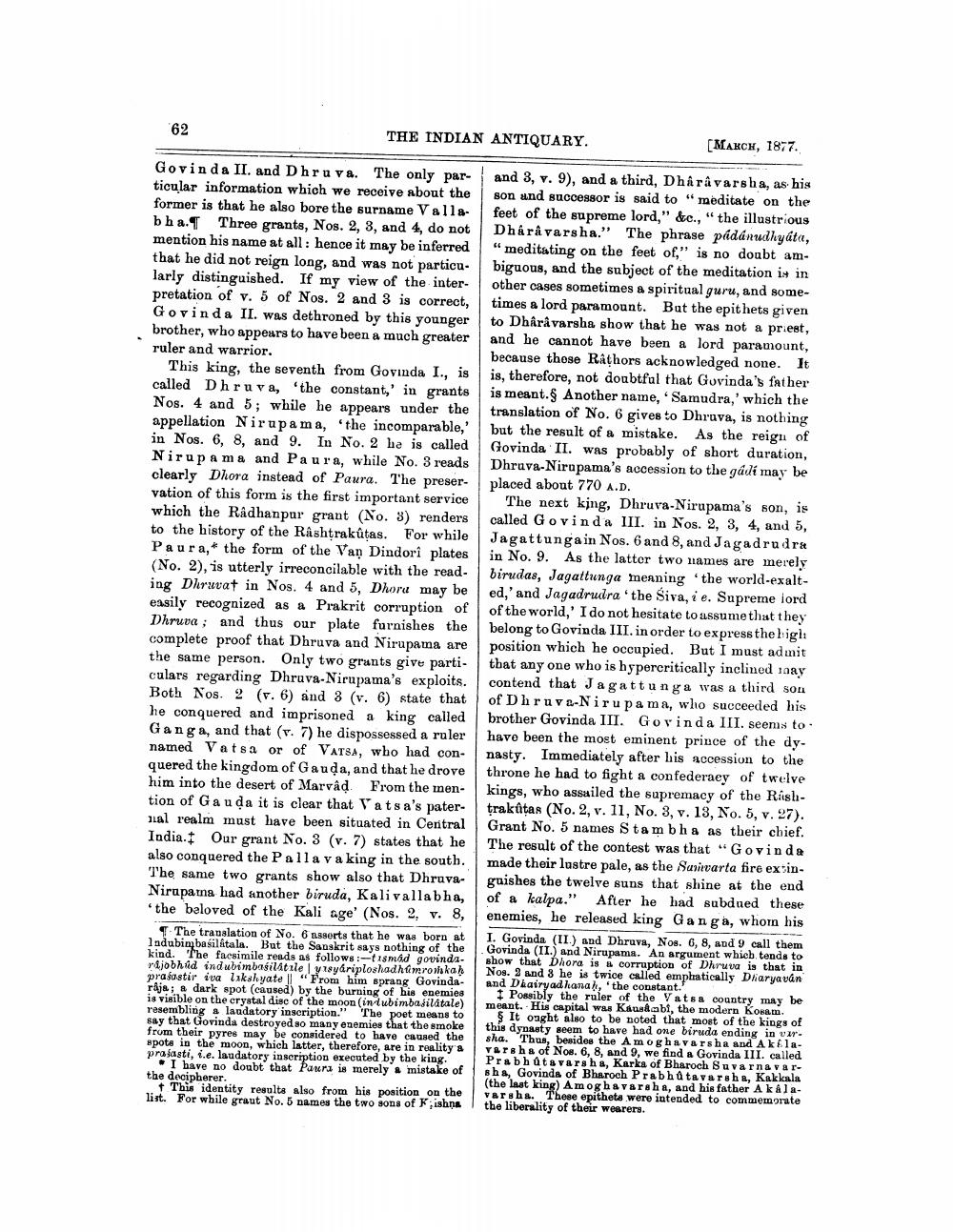________________
62
THE INDIAN ANTIQUARY.
[MARCH, 1877.
Govinda II. and Dhruv &. The only par- ticular information which we receive about the former is that he also bore the surname Valla bha. Three grants, Nos. 2, 3, and 4, do not mention his name at all: hence it may be inferred that he did not reign long, and was not particu. larly distinguished. If my view of the interpretation of v. 5 of Nos. 2 and 3 is correct, Govinda II. was dethroned by this younger brother, who appears to have been a much greater ruler and warrior.
This king, the seventh from Govinda I., is called Dhruva, 'the constant,' in grants Nos. 4 and 5; while he appears under the appellation Nirupama, the incomparable, in Nos. 6, 8, and 9. In No. 2 he is called Nirupama and Paura, while No. 3 reads clearly Dhora instead of Paura. The preservation of this form is the first important service which the Rådhanpur grant (No. 3) renders to the history of the Rashtrakūtas. For while Paura,* the form of the Van Dindori plates (No. 2), is utterly irreconcilable with the read. ing Dhruvat in Nos. 4 and 5, Dhoru may be easily recognized as a Prakrit corruption of Dhruva ; and thus our plate furnishes the complete proof that Dhruva and Nirupama are the same person. Only two grunts give parti. culars regarding Dhruva-Nirupama's exploits. Both Nos. 2 (F. 6) and 3 (v. 6) state that he conquered and imprisoned a king called Ganga, and that (v. 7) he dispossessed a ruler named Vatsa or of VATSA, who had conquered the kingdom of Gauda, and that he drove him into the desert of Marvad. From the mention of Gauda it is clear that Vatsa's pater- mal realm must have been situated in Central India. Our grant No. 3 (v.7) states that he also conquered the Palla va king in the south. The same two grants show also that Dhruva- Niraparna had another biruda, Kalivallabha, the beloved of the Kali age' (Nos. 2, v. 8,
The translation of No. 6 .sserts that he was born at lndubimba silátala. But the Sanskrit says nothing of the kind. The facsimile reads as follows: 18mad govindi- rijobhad indubimbasilatule yrsykriploshadhamrontakab pra fastir iva likshyate || “From him sprang Govindaraja; a dark spot (caused) by the burning of his enemies is visible on the crystal dise of the moon (in dubimbašilatale) resembling a laudatory inscription." The poet means to say that Govinda destroyed so many enemies that the smoke from their pyres may be considered to have caused the spots in the moon, which latter, therefore, are in reality prajasti, i.e. laudatory inscription executed by the king.
I have no doubt that Pauri is merely & mistake of the decipherer.
+ This identity results also from his position on the list. For while graut No. 5 names the two sons of Fishna
and 3, v. 9), and a third, Dhârâvarsha, as his son and successor is said to "meditate on the feet of the supreme lord," &c., “the illustrious Dhára varsha." The phrase pádánudhyata, “meditating on the feet of," is no doubt ambiguous, and the subject of the meditation is in other cases sometimes a spiritual guru, and sometimes a lord paramount. But the epithets given to Dhiravarsha show that he was not a priest, and he cannot have been a lord paramount, because those Rathors acknowledged none. It is, therefore, not doubtfal that Govinda's father is meant. Another name, 'Samudra,' which the translation of No. 6 gives to Dhruva, is nothing but the result of a mistake. As the reign of Govinda II. was probably of short duration, Dhruva-Nirapama's accession to the gadi may be placed about 770 A.D.
The next king, Dhruva-Nirupama's son, is called Govinda III. in Nos. 2, 3, 4, and 5, Jagattunga in Nos. 6 and 8, and Jagadrudra in No. 9. As the latter two names are merely birudas, Jagattunga meaning the world-exalted,' and Jagadrudra 'the Siva, i e. Supreme iord of the world,' I do not hesitate to assume that they belong to Govinda III. in order to express the bigla position which he occupied. But I must admit that any one who is hypercritically inclined 10ay contend that Jagattunga was a third son of Dhruva-Nirupama, who succeeded his brother Govinda III. Govinda III. seems to have been the most eminent prince of the dy. nasty. Immediately after his accession to the throne he had to fight a confederacy of twelve kings, who assailed the supremacy of the Rashtrakåtas (No. 2, v. 11, No. 3, v. 13, No. 5, v. 27). Grant No. 5 names Stam bha as their chief. The result of the contest was that "Govinda made their lustre pale, as the Suriwarta fire extin. guishes the twelve suns that shine at the end of a kalpa." After he had subdued these enemies, he released king Ganga, whom his 1. Govinda (II.) and Dhruva, Nos. 6, 8, and 9 call them Govinda (II.) and Nirupama. An argument which tends to show that Dhora is corruption of Dhruva is that in Nos. 3 and 3 he is twice called emphatically Dharyavan and Dhairyadhanah, 'the constant."
I Possibly the ruler of the Vatsa country may be meant. His capital was Kauskabi, the modern Kosam.
It ought also to be noted that most of the kings of this dynasty seem to have had one biruda ending in warsha. Thus, besides the Amoghavarsha and AkelaVarsha of No. 6, 8, and 9, we find a Govinda III. called Prabhatsvarsha, Karks of Bharoch Suvarna varsha, Govinda of Bharoch Prabhutavarsha, Kakkala (the last king) Amoghavsraha, and his father A kalavarsha. These epithets were intended to commemorate the liberality of their wearers.




